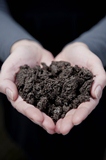Nematodes as soil health indicators
Hans Helder is working on a novel tool to monitor the impact of bio-based activities on soil and water environments. A key role is reserved for microscopic worms, the nematodes. These play an important role in soil health and are an indicator of the soil condition necessary for sustainable land use.

“Suppose you want to grow sugar cane on a massive scale, how can you show the impact that this has on the soil condition” says associate professor Dr Hans Helder of the Laboratory of Nematology of Wageningen University. “You need a reliable and affordable tool to monitor the ecological condition of the soil.”
That is easier said than done. Soil is one of the most bio-diverse environments on our planet, with bacteria, fungi and nematodes being among the main inhabitants. “Since you cannot measure the whole biodiversity of every soil sample, you have to search for a group of organisms that reflect the biological condition of the soil,” says Helder. Nematodes, microscopically tiny worms in the soil, are the perfect candidate for this. Nematodes as a group show a range of feeding habits, and are therefore present in every level of the soil food web. “They not only reflect their own condition, but also the condition of their food sources. If agronomic practices negatively affect soil fungi, an impact will be observed on one of more groups of fungi-eating nematodes. As a group, nematodes are an accurate indicator of the biological soil condition.”
Largest nematode DNA databank
There was one big challenge which had to be tackled first. All nematodes look alike. Only well-trained technicians and specialists are able to see the difference under the microscope, which has been the standard method of analysis up to now. “A time consuming job and not easy to scale up,” explains Helder. “Fortunately, the molecular diversity among nematodes is high. So we started looking at their DNA barcode. Over the years we screened all major North West European nematode families and built a databank that contains now over 2,500 species. This is currently the largest database of its kind worldwide.”
This knowledge resulted in the development of sensitive quantitative assays for the detection of plant parasitic nematodes for the agricultural sector. Together with Renske Landeweert from the agricultural service laboratory BLGG AgroXpertus, Helder recently founded ClearDetections, a start-up company that is about to launch a number of nematode detection kits on the market.
Monitoring natural fluctuations
For BE-Basic he is going to characterise natural fluctuations in nematode communities. Helder: “Since soil life differs over the seasons and different soil types harbour different nematode communities, we will be monitoring three different Dutch soil types throughout the seasons for three years.” The soil types – marine clay, river clay and sandy soils – have been selected from the RIVM BISQ (Biological Indicator for Soil Quality) network on the basis of their optimal ecological stability.
Within three years the BE-Basic partners in this project, Wageningen University, RIVM, BLGG AgroXpertus and Bioclear, will have generated an extensive nematode DNA database that gives insight in the band width (“seasonal fluctuations”) of individual nematodes within the community, the so-called normal operation ranges. “A combination of the monitoring tool and a database of natural fluctuations will allow us to carefully monitor the impact of human activities on the ecological condition of local soil and water environments,” says Helder. “Any type of agricultural activity is bound to have an impact on soil life. This is perfectly acceptable as long as these changes are reversible, and as long as no major soil functions are disrupted. These processes can be monitored with our tool kit for community analysis.”
The use of this tool is not limited to the Netherlands. Just like bacteria and fungi, nematodes can be found literally everywhere on Earth. Helder: “Research has revealed that soil nematodes show very little biogeography above genus level. So this tool developed in the Netherlands can also be used in other countries where BE-Basic is active, such as Brazil or Malaysia.”
Started
January 2010

